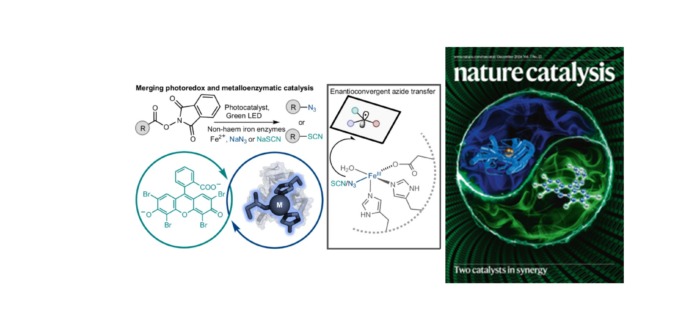The scope of nature’s catalytic abilities has been expanded by recent advancements in biocatalysis to include synthetic transformations with no biological equivalent. However, these newly introduced catalytic functions represent only a small fraction of reactions utilized in synthetic catalysis. Here we present a biocatalytic platform that combines photoredox and metalloenzymatic catalysis for enantioselective radical transformations. Under green light irradiation, the eosin Y photocatalyst enables 4-hydroxyphenylpyruvate dioxygenases to catalyse enantioselective decarboxylative azidation and thiocyanation of N-hydroxyphthalimide esters. The final optimized variant obtained through directed evolution can afford diverse chiral organic azide and thiocyanate compounds with up to 77% yield, 385 total turnovers and 94% enantiomeric excess. Mechanistic studies show that the eosin Y catalyst mediates the generation of both C(sp3) radical and Fe(III)-N3/Fe(III)-NCS intermediate, leading to efficient enantioselective C-N3 and C-SCN bond formation in the enzyme active site. These findings establish an adaptable biocatalytic platform for introducing abiological metallophotoredox catalysis into biology.
Dr. Garcia-Borràs is a co-corresponding author of the study, which was led by Prof. Xiongyi Huang from Johns Hopkins University, recently reported in the Nature Catalysis journal. Dr. Jordi Soler (former PhD student in Garcia-Borràs’ group) is the first computational author of this publication.
This work builds upon previous collaborative efforts, where the authors successfully incorporated a new radical-relay C(sp3)-H azidation reaction into a non-heme iron enzyme (Science, 2022, 376, 869-874, DOI: 10.1126/science.abj2830), and achieved enantioselective C(sp3)-F bond formation via iron-mediated radical fluorine transfer (Nat. Synth., 2024, 3, 958–966 (2024). DOI: 10.1038/s44160-024-00507-7).
This project is a core part of the research program that Dr. Garcia-Borràs leads at the IQCC, which is devoted to the use of computational methods in combination with experiments to characterize and design new abiological enzymatic activities and synthetically useful biocatalysts: “Biocatalytic intermediates for the discovery and design of new enzymatic activities“.
Research briefing:
Photoredox catalysis is merged with metalloenzymatic catalysis to enable asymmetric decarboxylative azidation and thiocyanation. These transformations are achieved by coupling the photoredox activation of N-hydroxyphthalimide esters using a synthetic photocatalyst with enantioselective radical capture by Fe(III) intermediates of non-haem iron enzymes.
The corresponding paper was published recently:
Jinyan Rui, Xinpeng Mu, Jordi Soler, Jared C. Paris, Yisong Guo*, Marc Garcia-Borràs*, Xiongyi Huang*
Merging photoredox with metalloenzymatic catalysis for enantioselective decarboxylative C(sp3)-N3 and C(sp3)-SCN bond formation
Nat. Catal. 2024, 7, 1394–1403
DOI: 10.1038/s41929-024-01257-7
Girona, 20th February 2025
For more info: ges.iqcc@udg.edu

